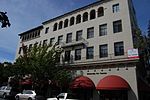Stanford Theatre

The Stanford Theatre is a classical independent movie theater in Palo Alto, California. It was designed and built in the 1920s as a movie palace styled in neoclassical Persian and Moorish architecture. Today it specializes in films produced between 1910 and 1970 and seasonal programs typically include film festivals for various genres, directors, and actors, such as Alfred Hitchcock, Bette Davis, and Cary Grant. The Stanford Theatre frequently accounts for as much as twenty-five percent of all classic film attendance in the United States.The Theatre has a "The Mighty Wurlitzer Organ" theatre organ made by Rudolph Wurlitzer Company. The organ is played live during intermissions, as well as to accompany silent films.
Excerpt from the Wikipedia article Stanford Theatre (License: CC BY-SA 3.0, Authors, Images).Stanford Theatre
Ramona Street, Palo Alto
Geographical coordinates (GPS) Address External links Nearby Places Show on map
Geographical coordinates (GPS)
| Latitude | Longitude |
|---|---|
| N 37.445208 ° | E -122.162666 ° |
Address
Stanford Theater
Ramona Street
94301 Palo Alto
California, United States
Open on Google Maps







